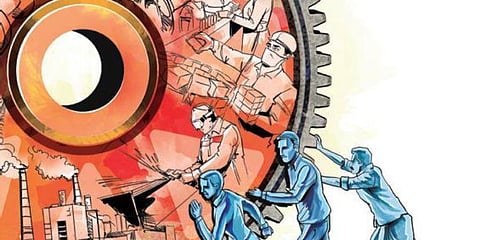

The Indian economy took the ribbon with a 13.5% growth in Q1, FY23. The latest numbers are in line with consensus estimates of 13-15%, but sorely missed the RBI's forecast of 16.2%. It means, the subsequent quarters have to make up for the under-delivery and ensure that FY23 GDP growth cracks at 7.2%.
Just two years ago around this time, national output contracted by an unspeakable 24% pushing the economy into despair. The National Statistics Office's provisional estimates released Wednesday showed real GDP at Rs 37 lakh crore in Q1, FY23, yet again firming up hopes of 2022 being a year of respair, even as 2021's anticipated Great Reset scarcely materialized.
ALSO READ | Unemployment rate dips to 7.6 per cent in April-June 2022: NSO survey
Analysts reason that a base effect of 20.1% growth during the same period last fiscal, the moderate impact of the Russia-Ukraine war and a recovering service sector activity to have supported growth.
What makes the double-digit 13.5% growth rate a pretty jingle is that, unlike in the past, Q1 numbers are promising given that the two vital, but lagging sub-components -- consumption and investment accounting for 88% of the GDP -- are ready to run laps, perhaps at twice the speed this fiscal, and make up for the lost ground.
Consumption, which alone accounts for 56% of the GDP -- saw a 26% jump over last year in spite of inflationary pressures and rising interest rates.
As per ICRA, the demand shift towards contact-intensive services from discretionary consumer goods for the mid-to-higher income groups is perhaps driving consumption. And given the cautiousness in export demand, and high commodity prices on volumes as well as margins for the industrial sector would translate to a relatively moderate industrial growth.
Private investment too is exhibiting signs of improvement with gross fixed capital formation growing by 20% in Q1, FY23 over the Q1, FY22. However, though the headline investment number seems encouraging, granular bank credit data shows that the share of large corporate projects is yet to make a complete revival.
However, government expenditure, which kept the economic momentum going during the pandemic years, settled for a slender growth of 1.3% in Q1, curiously breaking away from the government's tradition of frontloading spending in the first two quarters of the fiscal.
While growth in consumption, investments and government spending was in line with expectations, trade, particularly, exports surprised with a 14% growth in Q1, notwithstanding the anticipated blow due to geopolitical headwinds, high commodity prices and rupee depreciation. The April-June quarter bore the brunt of geopolitical disturbances due to the war and as supply chains were disrupted and commodity prices spiked. The Indian crude basket soared to $118 a barrel in early June and averaged $109.50 a barrel for the entire quarter. Still, exports managed to pack a wallop in Q1.
On the production side, the eight sub-components were a mixed bag. Agriculture and allied sectors stuck to its trendline 4% growth, manufacturing, the missing piece in the growth story, finally broke away from the negative territory clocking a 4.8% growth over the previous year. Construction, which too has been playing hopscotch, into turned in a 17% growth over last year. Overall, it's the services sector that found a fresh wind and sprung back with a robust 18% growth in Q1 over last year.
The deepest horrors of the Covid-pandemic barely halted, when 2022 met with double trouble via the Russian war and rising inflation, which threatened to wreck the modest recovery economies began making against odds. Then there are several little evils like exchange rate volatility, rising energy and commodity prices, foreign capital outflows and supply chain disruptions appearing like annoying pop-ups for emerging economies. In sum, what countries like India need isn't stratospheric growth rates, but efforts to avoid the setbacks from slowing down the recovery process.
This is essential not only for our own sake but also for the larger good. For, the IMF projects India's growth at 7.4% in FY23, contributing 14% to global growth. And India being the second most important driver of the world economy after China, which is showing signs of weakening, any slip-up in India's growth could scalpel out the global average. As it is, the world's largest economy, the US, is in a technical recession and if more join this sorry parade, even recovering economies could be hauled back into the sick bay.